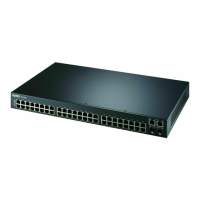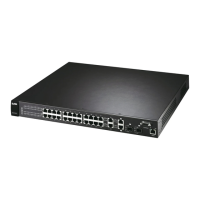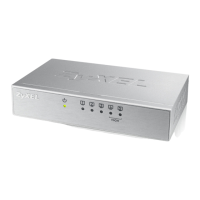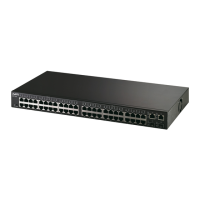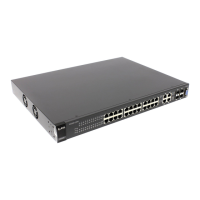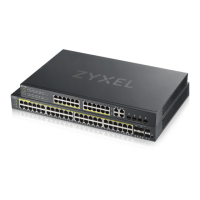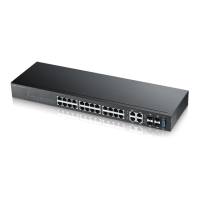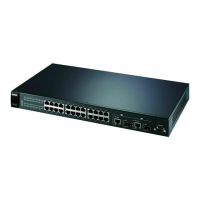
Do you have a question about the ZyXEL Communications ES-2024 Series and is the answer not in the manual?
| Switching Capacity | 8.8 Gbps |
|---|---|
| MAC Address Table | 8K |
| Jumbo Frame Support | 9 KB |
| Layer | Layer 2 |
| Power Supply | Internal |
| Operating Temperature | 0°C to 40°C |
| Model | ES-2024 |
Manual targets users familiar with TCP/IP networking concepts for web configurator usage.
Lists other guides like Quick Start, Online Help, CLI Reference, and website resources.
Provides contact information for submitting comments, questions, or suggestions for the user guide.
Lists information needed when contacting support, such as model, warranty, and problem description.
Explains how warnings (harm to you/device) and notes (important info/tips) are presented.
Defines formatting for product labels, keys, commands, screen navigation, and abbreviations.
Lists critical safety instructions for product usage, installation, and handling to prevent harm or damage.
Introduces the ES-2024 Series Ethernet Switch and its management capabilities.
Outlines methods for managing the switch, including Web Configurator, CLI, FTP, and SNMP.
Provides recommendations for enhancing switch security and effectiveness through regular practices.
Details the steps for placing the switch on a surface, ensuring proper clearance and attaching rubber feet.
Explains requirements and procedures for securely installing the switch into a standard network rack.
Describes the components and ports located on the front panel of the switch.
Details the components and connectors found on the rear panel of the switch.
Introduces the HTML-based management interface and browser requirements for switch configuration.
Guides users on how to access the web configurator by entering the IP address and initiating the login process.
Describes the initial screen displayed after successful login, showing system and port status.
Recommends changing the default administrator password for enhanced security.
Explains how to save configuration changes to run-time memory and non-volatile memory.
Details the process for reloading the factory-default configuration file to restore default settings.
Guides users on securely exiting the web configurator session.
Lists initial setup steps: creating a VLAN, setting port VLAN ID, and configuring management IP.
Details the process of configuring port 10 as a member of VLAN 2 using static VLAN settings.
Explains how to use PVID to tag incoming untagged frames for VLAN forwarding.
Guides on setting a custom management IP address for the switch in a different subnet.
Demonstrates configuring the switch to forward DHCP client requests to a specific DHCP server.
Provides steps to configure port 2 as a member of VLAN 102 for DHCP relay setup.
Details enabling DHCP relay and adding relay agent information to DHCP requests.
Offers steps to diagnose and resolve issues if a client does not receive the expected IP address.
Describes the home screen displaying port statistical summaries and links to detailed port information.
Guides on accessing the Status screen to view port statistics and details.
Explains how to view detailed performance data for individual ports.
Introduces configuration screens for System Info, General Setup, Switch Setup, IP Setup, and Port Setup.
Details how to view firmware version, temperature, fan speeds, and voltage on the System Info screen.
Guides on configuring general settings like system name, location, and time synchronization.
Explains configuring global switch features including VLAN type and MAC address learning.
Covers configuring default gateway, DNS server, and IP domains for switch management.
Guides on configuring individual switch port settings like speed, duplex, and flow control.
Describes how to view Power over Ethernet status and power allocation for connected devices.
Details setting priority levels for the switch in distributing power to Power Devices (PDs).
Explains VLAN membership identification using explicit tags in MAC headers.
Introduces GARP and GVRP protocols for automatic VLAN membership registration across switches.
Describes enabling VLAN Trunking on ports to pass frames belonging to unknown VLAN groups.
Guides on choosing between 802.1Q and Port Based VLAN types in the Switch Setup screen.
Explains using static VLANs to control frame forwarding based on VLAN tags.
Guides on configuring static VLAN settings on a per-port basis.
Details setting up port-based VLANs where forwarding decisions depend on destination MAC and associated port.
Discusses configuring forwarding rules based on device MAC addresses for network security.
Explains setting static MAC addresses for ports to reduce broadcasting needs.
Introduces static multicast MAC addresses for forwarding multicast frames without group membership.
Guides on configuring rules to forward specific multicast frames like streaming to selected ports.
Explains how to sift traffic based on MAC addresses and VLAN group IDs using filtering rules.
Explains how STP/RSTP detects and breaks network loops, providing backup links.
Details STP's mechanism for determining the lowest-cost spanning tree and enabling/disabling ports.
Describes the five STP port states used to prevent packet looping.
Introduces Multiple Spanning Tree Protocol (MSTP) and its features for complex network topologies.
Guides on selecting the STP mode (RSTP or MSTP) for the switch.
Details configuring RSTP settings like Bridge Priority, Hello Time, and Max Age.
Explains how to view the status of the RSTP configuration, including bridge IDs and times.
Details configuring MSTP settings, including bridge priority, max hops, and instance mapping.
Guides on capping maximum allowable bandwidth for incoming and outgoing traffic flows on a port.
Explains configuring broadcast storm control to limit broadcast, multicast, and DLF packets per second.
Details setting up port mirroring to copy traffic to a monitor port for examination.
Introduces link aggregation as grouping physical ports into a single logical, higher-capacity link.
Explains the Switch's adherence to IEEE 802.3ad for dynamic (LACP) port trunking.
Guides on configuring static link aggregation by selecting trunk groups for ports.
Details configuring LACP for dynamic link aggregation, including system priority and timeout settings.
Demonstrates creating a static port trunk group for ports 2-5 using physical connections and configuration.
Explains port authentication for validating access based on external server credentials using 802.1x.
Illustrates the client validation process through username and password credentials via a RADIUS server.
Guides on activating port authentication methods and configuring RADIUS server settings.
Details enabling 802.1x security on the switch and individual ports, including reauthentication timers.
Explains allowing only authenticated MAC addresses to pass through a port for enhanced security.
Guides on enabling port security and configuring MAC address learning and limits.
Demonstrates various port security configurations and their resulting behavior.
Introduces queuing for solving network congestion by prioritizing traffic flows.
Guides on setting up queuing algorithms like Strictly Priority and Weighted Round Robin.
Explains how multicast delivers IP packets to specific groups of hosts on the network.
Details how the switch snoops on IGMP packets to learn multicast group membership.
Describes configuring IGMP snooping on up to 16 VLANs, in auto or fixed mode.
Guides on configuring multicast settings including IGMP snooping, filtering, and unknown multicast frame handling.
Explains creating profiles to specify allowed multicast IP address ranges for clients.
Introduces Multicast VLAN Registration (MVR) for sharing a single multicast VLAN among subscriber VLANs.
Guides on creating multicast VLANs and setting receiver/source ports for MVR.
Details configuring MVR IP multicast group addresses and their associated settings.
Explains AAA processes for user access control, privilege levels, and activity recording.
Guides on configuring authentication server settings (RADIUS, TACACS+) and priority.
Details configuring RADIUS server settings for authentication and accounting.
Guides on configuring TACACS+ server settings for authentication and accounting.
Covers configuring authentication and accounting settings, including methods and event types.
Explains Vendor Specific Attributes (VSAs) for customizing RADIUS server functionality.
Introduces IP Source Guard for filtering unauthorized ARP packets using a binding table.
Explains ARP inspection for preventing man-in-the-middle attacks by filtering unauthorized ARP packets.
Guides on managing static bindings for ARP inspection, uniquely identified by MAC and VLAN ID.
Details viewing current MAC address filters created due to unauthorized ARP packets.
Explains viewing log messages generated by ARP packets not yet sent to the syslog server.
Guides on enabling ARP inspection and configuring filter aging time and log profiles.
Details specifying trusted or untrusted ports for ARP inspection.
Guides on enabling ARP inspection per VLAN and configuring log message generation.
Explains Loop Guard for shutting down ports detecting looped-back packets, protecting against edge network loops.
Guides on enabling the Loop Guard feature on the switch, noting compatibility with STP.
Introduces static routes for switch communication with unreachable management stations or servers.
Guides on creating static routes by specifying destination IP, subnet mask, gateway, and metric.
Explains Quality of Service (QoS) and DiffServ models for prioritizing traffic flows based on DSCP markings.
Guides on configuring DSCP to 802.1p mapping for traffic prioritization based on incoming DSCP values.
Introduces DHCP for obtaining TCP/IP configuration and configuring the switch as a DHCP relay agent.
Details configuring global DHCP relay to forward all DHCP requests to a single DHCP server.
Guides on configuring DHCP settings on a per-VLAN basis, requiring management IP per VLAN.
Provides a network example and configuration steps for DHCP relay across two VLANs with different DHCP servers.
Introduces the screen for managing firmware and configuration files, including upgrade, restore, backup, and reboot.
Details the process of resetting the switch configuration to its factory default settings.
Explains how to save current switch configuration settings permanently to Configuration 1 or the current configuration.
Guides on restarting the switch without physically turning off the power, loading configuration one.
Details the procedure for upgrading the switch firmware, emphasizing the need for the correct model.
Explains how to load a previously saved configuration file from a computer to the switch.
Guides on creating configuration backups (snap shots) for later restoration.
Covers uploading/downloading files using FTP commands, including filename conventions and procedures.
Summarizes access control methods for console, Telnet, SSH, FTP, Web, and SNMP sessions.
Introduces the main screen for managing access control features like logins and service access.
Explains Simple Network Management Protocol (SNMP) for managing and monitoring network devices.
Discusses SNMP v3 enhancements for security, including authentication and encryption.
Lists the supported Management Information Bases (MIBs) for collecting statistics and monitoring performance.
Outlines the SNMP traps sent by the switch when specific events occur, categorized by type.
Guides on setting up SNMP versions, community strings, and trap destinations for network management.
Details configuring administrator and non-administrator login accounts for web access.
Introduces SSH as a secure communication protocol for authentication and data encryption.
Summarizes the secure connection establishment process between SSH client and server.
Describes SSH version 2 support for remote management and file transfer.
Explains HTTPS for secure web access, involving certificates and SSL/TLS encryption.
Provides guidance on accessing the switch via HTTPS, including browser security alerts.
Allows deciding which services to access the switch with and configuring trusted computers.
Guides on specifying trusted computer groups for managing the switch via services like Telnet, SSH, etc.
Explains using the diagnostic screen for checking system logs, pinging IP addresses, and performing port tests.
Introduces the syslog protocol for sending event notification messages to a syslog server.
Guides on configuring device system logging settings and enabling the syslog feature.
Details configuring a list of external syslog servers to receive logs from the device.
Introduces managing switches through a single cluster manager switch for communication within a VLAN.
Guides on viewing the status of cluster members, including their role, MAC address, and online/offline state.
Explains how to access cluster member switches' web configurator home pages from the cluster manager.
Details using FTP via the cluster manager to upload firmware to member switches.
Guides on configuring cluster management, including setting up the cluster manager and adding candidate members.
Introduces the MAC Table screen, showing how frames are forwarded based on MAC addresses and VLAN groups.
Guides on displaying and sorting MAC address entries based on condition, sort order, and type.
Introduces ARP for mapping IP addresses to physical MAC addresses on a local network.
Guides on displaying IP-to-MAC address mappings using the ARP table.
Explains copying port settings (basic and advanced) from a source port to destination ports.
Summarizes the switch's hardware details including dimensions, weight, power consumption, and port types.
Lists and describes key features like VLAN, MAC Address Filter, DHCP, STP, and Port Mirroring.
Introduces IP addresses and subnet masks for identifying devices and dividing networks.
Explains how subnet masks determine network and host ID portions of an IP address.
Discusses calculating the maximum number of hosts based on subnet mask and host ID bits.
Details using subnetting to divide one network into multiple sub-networks for security or organization.
Guides on obtaining and assigning IP addresses and subnet masks for network devices.
Lists IANA-reserved IP address blocks for private networks and guidelines for assignment.
States copyright information and content usage restrictions.
Outlines ZyXEL's liability limitations regarding product application and use.
Lists registered trademarks and mentions other trademarks used for identification.
Details FCC interference statement and compliance for Class B digital apparatus.

